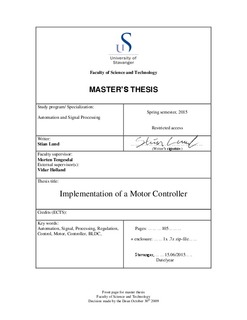| dc.description.abstract | This thesis is written for E Plug, a company that specialises in down-hole operations in the oil industry.
Brushless DC (BLDC) motors are being used almost everywhere in todays market. The BLDC motor can be found in vacuum cleaners, dryers, air conditioners, electrical bikes, medical equipment, aerospace technology etc. It is now increasingly being used in the oil industry. The BLDC motor is known to be efficient, silent, compact and has a long operational lifetime and reduced maintenance time compared to other DC motors. Because of the lack of brushes, the motor is optimal to use in the oil industry as it won’t generate any dangerous sparks which can be a problem with brushed motors.
The challenge with a brushless motor is that it requires an efficient driving code implemented in a microcontroller. The rotor position is unknown and the motor need some sort of logic to determine the position, so that it knows when to give the rotor a "push”. The brushed motors are easier to control as the brushes constantly provides feeback on where the rotor is. In this thesis three different driving codes are implemented in a microcontroller, tested and analysed. The first method is sensorless control, which is based on back-EMF detecting. This method provides an unstable and unpredictable start up time for the motor, as back-EMF sensing isn’t available on low speed operations. The second methods uses Hall-effect sensors which gives feedback on where the rotor is. This method provides a stable response and is very effective. The third method uses an optical encoder with a more complex code that takes use of the benefits of shunt resistors. By sensing the phase currents and using the measurements to control the stators magnetic field, the motor can be regulated to operate at it’s maximum torque per amp. This method shows to be clearly the most precise and effective way of controlling the motor.
A use of resolver for detecting rotor position was planned to be implemented. Because of the hardware needed for this control wasn’t available, it had to be discarded. As most of the time working on the thesis went to implementing the different methods, there wasn’t so much time as hoped to analyse the results. One of the other goals was to implement the different methods on a second microcontroller, which is based on floating-point unit instead of fixed-point unit. As this task became too extensive, this goal was discarded as well. | nb_NO |
